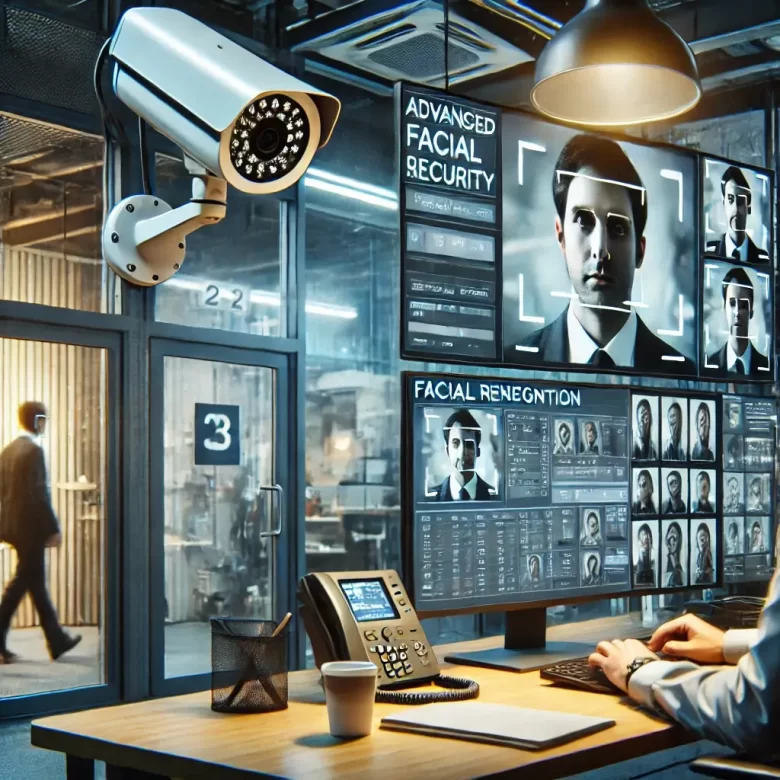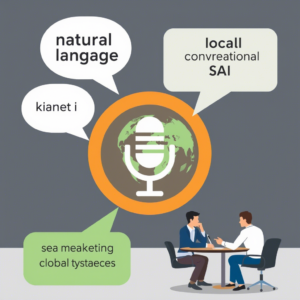The use of facial recognition technology has been growing exponentially across various sectors, and one of the most benefited areas is security and monitoring.
The application of this advanced technology in small security businesses can provide enhanced protection, more efficient access control, and automation of processes that previously relied entirely on human supervision.
In this article, we will explore how facial recognition can be practically implemented in small security and monitoring businesses, the key benefits of this technology, and how to overcome the most common objections that arise during its adoption. We will also discuss the challenges and precautions necessary for the ethical and effective use of this technology.
What is Facial Recognition?
Before diving into practical applications, it’s important to understand what facial recognition is. This technology involves identifying or verifying a person’s identity based on an image, photo, or video of their face. Using complex algorithms, facial recognition software compares the unique features of a face with images stored in a database, looking for a match.
How Facial Recognition Works
The process can be divided into three main steps:
- Image Capture: Cameras installed at the location capture images or videos of people moving through the monitored area.
- Data Processing and Analysis: The facial recognition software maps specific facial features such as the distance between the eyes, and the shape of the nose and mouth, creating a digital model.
- Comparison and Identification: The system compares this model with the faces stored in the database. If a match is found, the person is identified. If not, the system registers the face as unknown.
Variety of Technologies Involved
There are different facial recognition technologies that can be used according to the business needs. Let’s look at some of the most common ones:
- 2D Image-based Recognition: The most common, using photos or videos captured by traditional security cameras. While effective, it can face issues under poor lighting conditions.
- 3D Recognition: Uses special sensors to map the face in three dimensions, providing greater accuracy, especially at different angles or in low-light environments.
- Real-Time Verification: Essential for security systems, this technology identifies faces in motion and in real time, allowing alerts to be issued instantly.
Why Small Businesses Should Adopt Facial Recognition
Although implementing a facial recognition system might seem like something reserved for large companies, small businesses can also benefit significantly from this technology, especially in security and monitoring. Below are some of the key reasons why small businesses should consider adopting this technology:
Improved Security: For businesses that depend on physical security, such as stores, offices, or even small residential buildings, facial recognition provides a more effective way to quickly identify who is entering the premises. By replacing or complementing traditional security systems like access cards or passwords, facial recognition offers an additional layer of control and security.
For example, imagine a small office building. By using cameras with facial recognition, it’s possible to ensure that only authorized employees enter restricted areas, without relying on access cards that can be lost or stolen.
Access Control Automation: One of the biggest benefits of facial recognition is the automation it provides. Small businesses can use this technology to control access to restricted areas without the need for an employee to be present to check each person’s entry. This can be especially useful in places with constant foot traffic, like commercial buildings, gyms, or distribution centers.
Additionally, automation brings cost savings. By not relying on a security team to monitor every entry and exit, the business reduces operational costs and increases security system efficiency.
Reduction of Risks and Losses: In the retail sector, facial recognition can be a valuable tool in preventing theft and identifying individuals with a history of suspicious or criminal activities. Small businesses frequently facing issues with theft or vandalism can implement this technology to detect behavioral patterns and issue alerts automatically, enabling employees to take preventive measures before a loss occurs.
For example, a convenience store could install facial recognition cameras in strategic locations like the entrance and checkout. Upon detecting a suspicious individual, the system could alert the manager, allowing them to monitor the situation closely and prevent a potential theft.
Better Customer Experience: Facial recognition isn’t just limited to security. In some types of businesses, it can be used to improve the customer experience. For instance, a small hotel could use this technology to recognize returning guests and offer more personalized service, such as greeting them by name or automatically adjusting room preferences like temperature and lighting.
Operational Efficiency: Another important benefit of facial recognition technology in small businesses is improved operational efficiency. By automating security processes like access control or monitoring, business owners can focus more on other strategic areas. Moreover, implementing an automated system can free up employees from repetitive and bureaucratic tasks, increasing productivity and job satisfaction.
Common Objections to Facial Recognition and How to Overcome Them
While the benefits of facial recognition are clear, it’s common to encounter objections regarding its adoption, especially among small businesses. The two main objections typically relate to privacy and cost.
- Privacy Concerns: The main concern surrounding facial recognition technology is privacy. Many fear that their biometric data could be misused or stored improperly, leading to privacy violations. In small businesses, data protection and customer trust are crucial for business continuity.
How to Overcome Privacy Objections
To overcome this objection, it is essential that small businesses are transparent about how the collected data will be used. Here are some practical tips:
Clearly Explain the Use of Data: Inform customers and employees about how their facial recognition data will be used and for how long it will be stored.
Apply Consent Policies: Ensure that individuals consent before their facial information is captured and offer them the option to opt-out of the system.
Comply with Data Protection Laws: Ensure your business complies with regulations like Brazil’s General Data Protection Law (LGPD) or the European Union’s General Data Protection Regulation (GDPR) to protect individuals’ rights.
Cost Concerns: Another common objection is the cost of implementation. Small businesses often believe that advanced technologies like facial recognition are unaffordable due to high initial investment. However, with growing demand and technological advancements, installation and maintenance costs have been decreasing.
How to Overcome Cost Objections
There are various ways to overcome this objection:
Highlight the Return on Investment (ROI): In the long term, facial recognition systems can generate savings by reducing the need for security personnel and preventing losses from theft.
Scalable Solutions: Many technology providers offer scalable solutions that can grow as the business evolves, allowing small businesses to start with a basic system and expand as necessary.
Explain the Strategic Value: Emphasize strategic benefits such as improved security and automation, which can result in a more efficient and profitable operation.
Practical Applications in Small Businesses
Monitoring in Small Offices: Imagine a small consulting business with about 20 employees. Instead of relying on badges or cards to secure office access, the business could install a facial recognition system at the entrance. This not only ensures that only authorized employees and visitors enter the building but also eliminates the risk of lost badges, increasing security. Additionally, the system can be programmed to log each employee’s entry and exit times, automating time-tracking management.
Access Control in Gyms: Small businesses in the fitness sector, like gyms, can use facial recognition to ensure that only members with current subscriptions have access to the facilities. Besides increasing security, this technology also enhances the customer experience by allowing quick entry without the need to show a membership card or check in at the reception.
Loss Prevention in Retail: In small retail stores, like grocery stores or pharmacies, facial recognition can be integrated with the security camera system to identify suspicious individuals and automatically alert employees. If someone with a history of theft attempts to enter the store, the system can notify the security team, allowing for proactive action.
Security at Small Events: Businesses that organize small events, like trade shows or conferences, can also benefit from implementing facial recognition to quickly and efficiently verify the identity of participants, preventing fraud or unauthorized entries.
Implementing Facial Recognition: A Step-by-Step Guide for Small Businesses
If your small business is considering adopting facial recognition, here is a basic guide to ensure a successful and efficient implementation:
Assess Your Needs: The first step is to understand what security needs your business has. Are you concerned about access to restricted areas? Or do you want to improve entry and exit control? Knowing what you need will help you choose the most suitable solution.
Choose the Right Technology: There are many facial recognition solutions available, each with different features. For small businesses, it’s important to choose a solution that offers accuracy, scalability, and ease of use.
Integrate with Existing Systems: If you already have security cameras or access control systems, make sure the new facial recognition system is compatible with them. This can ease the transition and avoid additional costs.
Ensure Compliance with Privacy Laws: Before implementing the system, ensure your business complies with privacy laws in place. This includes obtaining consent from individuals and securely storing the data.
Train Your Team: Finally, make sure your team is well-trained to operate the system and handle any issues that may arise. While facial recognition technology is advanced, it requires staff to know how to use it efficiently.
Conclusion: The Future of Security for Small Businesses
Facial recognition is quickly becoming an essential technology for small businesses in security and monitoring, thanks to its ability to enhance security, reduce operational costs, and improve the customer experience. By overcoming common objections such as privacy concerns and cost, small business owners can confidently adopt this technology, knowing it will provide significant long-term value.
With continued automation and ongoing improvements in security technologies, facial recognition will continue to evolve, becoming more accessible and effective for businesses of all sizes.
FAQ – Frequently Asked Questions
Is facial recognition secure for small businesses? Yes, when implemented correctly, facial recognition can be an extremely secure technology for small businesses. Ensuring data protection policies and compliance with current legislation is crucial.
What are the costs associated with implementing a facial recognition system? Costs vary depending on the chosen solution, but with increasing popularity, options are becoming more affordable. There are also scalable solutions that allow businesses to start small and expand as needed.
How does facial recognition improve security in small businesses? Facial recognition enables more rigorous access control, automates processes, and quickly identifies suspicious individuals, increasing security for both customers and employees.
What are the privacy concerns with using facial recognition? The main concerns involve the collection and storage of biometric data. To ensure privacy, it’s important for the business to clearly communicate how the data will be used and store it securely.
Can facial recognition be used to improve the customer experience? Yes, in many cases, facial recognition can be used to personalize customer service. For example, hotels can use the technology to offer a more personalized experience to returning guests.
Can facial recognition completely replace security personnel? While facial recognition can automate many security processes, it should be seen as a complementary tool, not a complete replacement for human staff.
How can facial recognition help prevent losses in retail? In retail stores, facial recognition can identify suspicious individuals based on past behavior and automatically alert security, helping to prevent theft.




